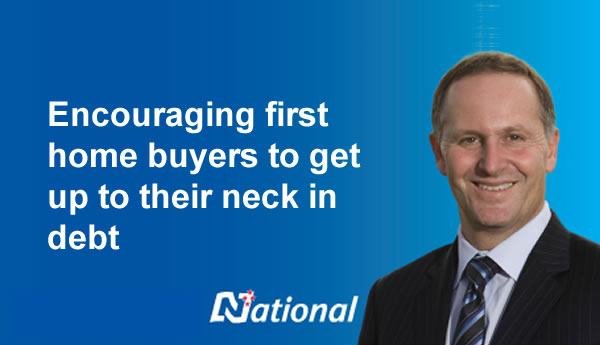The property market is New Zealand’s drug of choice – and Auckland and Christchurch are the chief junkies at the moment. Today National implements its election promise to create a gateway drug for the middle class, by boosting the Kiwisaver subsidy for people looking to buy their first house, particularly if that house is newly built. Instead of trying to wean people off the housing market kick, National wants to help middle-class first home buyers get hooked big time.
New Zealand’s housing market is overheated – no one is arguing about that. The best way to measure that is by comparing house prices with our income. Across New Zealand, the average house price is 5.5 times the average household income. In Auckland, that rises to a factor of 8, making it one of the most unaffordable cities in the world. Only low interest rates have been keeping mortgage repayments affordable, a situation that won’t last forever.
The house price boom in Auckland has hit first home buyers hard, a situation that was made worse by the Reserve Bank’s decision to restrict borrowing to those who could afford less than a 20% deposit. The RB’s policy had no impact on investors who had plenty of equity after recent price increases.
National’s response is to increase the first home buyer subsidy built into Kiwisaver. For some time now first home buyers who are earning below $80,000 (or $120,000 if they are a couple, another disincentive to be in a relationship) have been able to withdraw from their Kiwisaver accounts to pay the deposit on their first home, and get a top up (subsidy) from the Government as well. National has now upped the government subsidy and increased the price limits of the homes that the subsidy applies to. That subsidy is higher for newly built homes, in an attempt to encourage more building.
Subsidy for the middle-class
There are a number of problems with this policy. Firstly it is a decidedly middle class subsidy – it won’t help those that could never afford their own home. At a cost of $435m over four years is that really the best use of limited government money? New research suggests that house price rises are the biggest driver of inequality – this policy will only make the gap between haves and have nots bigger.
Impact on house prices
The Opposition has claimed that this policy will simply stoke the fire and set house prices roaring further. National counters that by upping the subsidy for new building, they will increase the demand for new houses to be built. Who’s right? And where are the builders anyway? The short answer is that we don’t know. All we know is that it first home subsidies haven’t worked in Australia. National is hoping things will be different here, but it is hard to share their optimism.
Impact on affordability
Perhaps the most concerning aspect of National’s proposal is that they are encouraging first home buyers to get up to their neck in debt:
National gives the example of a couple in Auckland both earning $50,000 a year who have been in KiwiSaver for five years: they could withdraw $35,000 from KiwiSaver, receive a $20,000 new home grant, giving them a $55,000 deposit. For the Welcome Home Loan scheme they would need a 10 percent deposit, and so could borrow to buy a house costing up to $550,000.
This hypothetical couple would be paying a $500,000 mortgage on a combined gross income of $100,000. With long term interest rates over 6% (and likely to eventually head upwards), this would means repayments are well above the level defined as unaffordable (where households spend more than 30% of their disposable income on housing costs). Is the answer to our house price crisis to help our young people saddle themselves with a lifetime of debt?3
What are the real issues?
This announcement, like those of most parties, does little to deal with the fundamental problems facing our housing industry. These are:
Tax policy turning a blind eye to non cash income, particularly the benefits owners get from housing and land. While rental properties and farms are taxed as a business, the capital gains they receive are not considered taxable income. Equally important, the rental equivalent of the shelter provided to owner occupiers are not taxed either. Given the tax advantages, who wouldn’t invest in housing if they have the money?
A directive to banks from the Reserve Bank to favour lending on mortgages over other forms of lending. The Reserve Bank has tweaked around the edges through their higher capital requirements for low equity loans, but there is more to do. A radical rethink on taxing housing would help.
Local government distributes the costs of supplying services to new subdivisions across all rate payers. People who want to live in newly developed subdivisions should face the full cost of their choice, not a lesser amount. It is often seen as ‘cheaper’ to build on the fringes, but if the full costs were included, they wouldn’t look so cheap. For example, developers should pay the full cost of the additional infrastructure on the fringes – including the transport links required for people to get to work. Inner city living would start to look more inviting.
In short, at best National’s new policy is unlikely to help our housing woes, and at worst it could increase prices. Either way all it will do is help saddle a new generation of middle class youngsters with debt. Which makes you wonder – if housing is New Zealand’s drug, does this policy make National a pusher?

